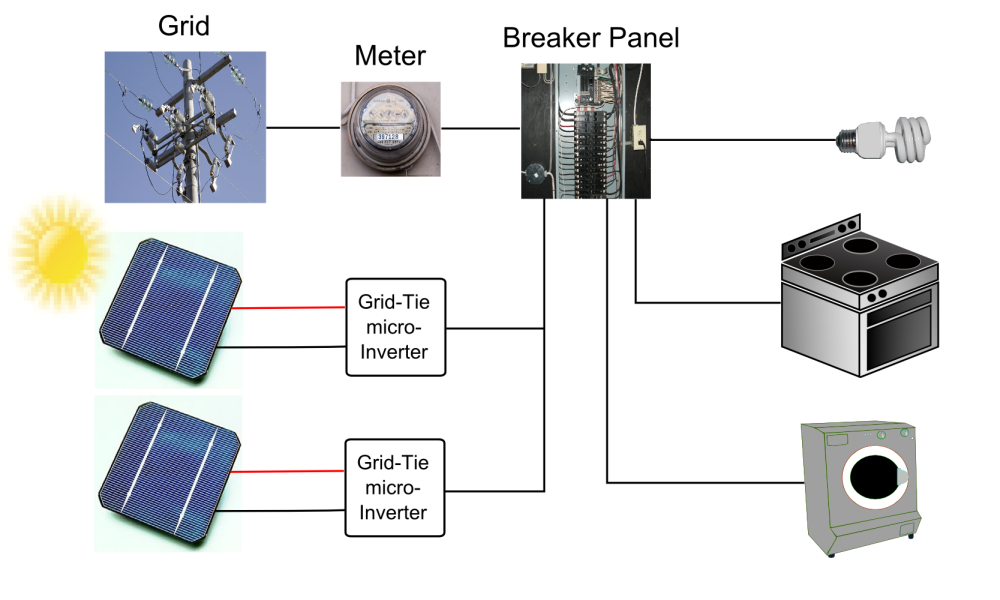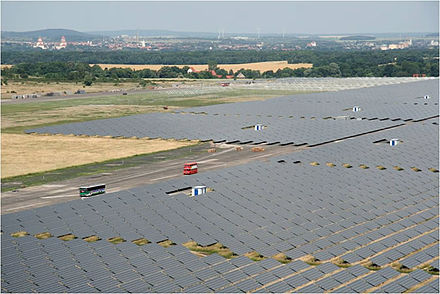-
-
-
-
Clean Energy Council has informative site for consumers about solar. Click on the following link to find out more.
-
Another site for consumer information regarding connection to the grid is the following NSW Government site.
-
We recommend SMA, a leading German inverter manufacturer of a quality and reliable product. This link will take you to SMA Australia website.
-
One of the solar projects that we have completed was the installation of a 12kw system with a three phase inverter at St Patricks School Lithgow 2790 NSW. The system is monitored via the internet and to access the information and track the performance click here.
-
Supporting Australia to reduce, offset and track our emissions. Accelerating carbon abatement for Australia
-
Auzzie.Biz Domain Services is committed to providing quality of service in Web Hosting, Web Site Planning, Web Site Design, Management and Promotion, and Domain Name Registration.
-
-
-
Please be patient, the file below will take a while to load….
All about Solar Photovoltaic
Please be patient, the file below will take a while to load….
Consumer Guide to buying household solar panels
Make the best use of your solar
To take advantage of the power your PV solar system is producing you need to understand at what times it is working the best.
Because the panels only work in the daylight hours you have already eliminated at least 12 hours of the day when the panels will not be working.
The graphs below are tacken from a 3kw system with the panels mounted on the west roof with a pitch of 15 degrees. The panels are mounted on tilt frames facing north at approx. 30 degrees. This means that they will work better in the afternoon. For best results from your panels over the year they should be tilted at the approx the same angle facing north as the degrees south you are from the equator. Therefore if you live in Sydney or similar latitude this would be approx 30 degrees.
Having said this it is noted that the majority of new connection to the grid are connected via a NET meter. This means that the house hold firstly uses the power from the PV solar system and any excess is then exported to the grid.
How does solar work
When you think renewable energy, chances are your mind fills with the image of solar photovoltaic cells adorning rooftops. But how do they work? How do the panels convert sunlight into electricity?
Your power bill explained
Your electricity is measured in kwh.
What is kWh?
- kWh is a unit of energy.
- kWh = kilo Watt hour.
- Watt is a unit of power.
- A kilo is a one thousand multiplier.
- A kWh is the amount of power consumed/generated over a period of one hour.
- For example, a 100 Watt light globe left on for 10 hours would consume 1kWh, that is, 100 Watts x 10 hours = 1,000 Watt hours = 1kWh.
- 1kWh = 3.6 Mega Joules.
- 1kW = 1.34 Horsepower.
What is a STC?
Small-scale Technology Certificates (STCs) are created by eligible installations of Solar Water Heaters (SWH), Air Source Heat Pump Water Heaters and Small Generation Units (SGU) (small-scale solar photovoltaic panels, wind and hydro systems). A STC is generally equivalent to:
- 1 MWh of renewable electricity deemed to be generated by Small Generation Units unless the Solar Credits REC multiplier applies; or
- 1 MWh of electricity deemed to be displaced by the installation of Solar Water Heaters or Air Source Heat Pump Water Heaters.
Solar Qs & As
How does a solar PV system work?
When sunlight hits a solar PV panel, direct current (DC) electricity is produced and the inverter changes the current from DC to 240V alternating current (AC). This electricity can be used immediately within the home or fed into the National Electricity Grid (grid).
What is a solar photovoltaic (or PV) system?
A solar photovoltaic (PV) system is made up of solar PV panels, an inverter, racking and wiring.
Solar PV systems work very simply to provide a household or commercial structure with usable, renewable, clean, green energy.
Flat solar PV panels are mounted to a roof and convert energy from sunlight into direct current (DC) electricity. A device called an inverter then changes the DC into 240V alternating current (AC) electricity, which can be used for a household’s electrical needs such as lighting and operation appliances.
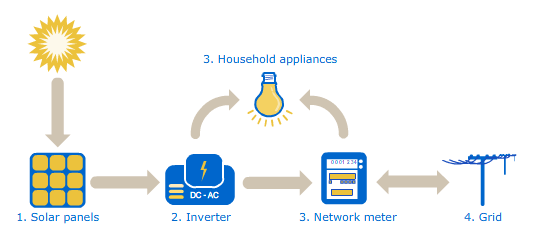
What is the National Electricity Grid?
The National Electricity Grid is the network of wires that delivers electricity from generators to homes and businesses. When you install a solar PV system you become a generator of electricity which can be fed into the grid. As this electricity is generated from the sun it is clean renewable energy.
What is the difference between a solar hot water system and solar PV system?
A solar hot water system uses the sun’s warmth to directly heat water.
A solar PV system converts sunlight into electricity for use in the home or to be fed into the electricity grid. The heat output of the sun is not important for solar PV systems, but the amount of sunlight available is.
What are the different types of solar PV panels?
There are many different types of solar PV panels currently on the Australian market. The three main types are monocrystalline, polycrystalline and thin film panels.
A range of materials can be used to produce a PV panel, the most common is silicon. But there are now newer technologies which are proving to be effective in Australian conditions.
Does the orientation of the roof affect whether or not a home can successfully install a solar product?
Although it is optimal to install solar products on the north-facing side of a roof, it is also possible to install a solar PV system on the east or west facing side of a roof, as long as there is sufficient space. However, this will not produce the same results as a north–facing installation.
Is mains electricity still needed?
Because solar PV systems only produce electricity when they are exposed to sunlight, at other times another source, such as mains electricity or a generator, will be required. When there is no sunlight, no electricity is produced, so you will need to draw electricity from another source such as the grid.
Are batteries needed for a solar PV grid connected system?
No. Grid–connected solar systems do not store electricity – instead, any electricity you do not use in your home is ‘exported’ to or fed into the electricity grid.
Is it possible to increase the size of a solar PV system in the future?
This depends on your roof space and the size of the inverter. If you have sufficient roof space and additional capacity in the inverter you could increase the size of your system. Or you could add a second system to your roof.
Please note:At this time, the solar feed-in tariffs in each state have limits on the system size which to they apply. Increasing the size of an existing solar PV system could affect your eligibility for a feed-in tariff.
What happens at night?
As solar PV systems only produce electricity when they are exposed to sunlight, they do not produce electricity at night. At night you will need another source, such as electricity from the grid.
What happens on cloudy days?
The performance of the solar PV system is affected by cloud cover. When there is not enough light to produce electricity, you will use electricity from the grid.
What will happen during a blackout?
For safety reasons, in the event of a blackout, your solar PV system will stop producing electricity. This safety measure is mandatory and has been put in place to protect anyone working on the blacked-out grid system. As soon as the grid is back online, your solar PV system’s ability to generate will be restored.
Where do residential solar PV panels get placed?
Your installer should determine the optimal position for your solar PV system.
There are many factors to take into consideration when planning the placement – from orientation to the sun, to the area available and the distance to the meter. In an ideal situation, the panels would be oriented as close to north–facing as possible, in an area with no shading.
Is it true that solar electricity systems are more efficient inland rather than on the coast?
There are many factors affecting efficiency. Inland regions generally have fewer cloudy days than the coast. Conversely, high temperatures, smog and dirt are more prevalent inland and can also affect performance.
How much electricity does a solar PV system produce?
There are a number of factors that will affect how much electricity a system will produce. The orientation of the panels, where you live in Australia, any shading of your panels and the amount of sunlight on a given day will all affect how much energy the solar PV system produces. You should refer to the product specifications of the solar power system you are considering, or talk to your installer.
What are Small-scale Technology Certificates (STCs)?
STCs are created under the government’s Small Scale Renewable Energy Scheme. SRES is part of the government’s Renewable Energy Target initiative which create a financial incentive for investment in renewable energy sources through the creation and sale of certificates. Each STC represents 1 MWh (Megawatt hour) of energy able to be produced.
STCs are created when you purchase qualifying solar hot water, wind power systems or residential solar PV systems.
SRES and the associated creation and sale of STCs was devised to encourage Australians to take action to help meet the government’s 20% renewable energy target by 2020.
How much are STCs worth?
The value of the STCs you are eligible for varies depending on your location and zone rating, the size of the system you install and the market value for STCs. Website’s such as the Government’s Office of Renewable Energy Regulator site have solar STC calculators, providing a guide to the number of STCs your system could be worth.
Do I have to sell my STCs as part of installing a solar power system bought from AGL?
Generally when purchasing a solar PV system and having it installed by an installer ,you will be asked to assign your STCs to installer. The value of STCs is usually applied as a discount, reducing the upfront costs of the solar PV system. Customers should consult their solar PV system installer for confirmation on the process.
What is a feed-in tariff?
A feed–in tariff is the rate paid for any electricity your solar PV system feeds into the grid. The rate which is paid varies depending on your state and whether you are eligible for a government feed–in tariff or not.
To be eligible for feed–in tariff payments, you need to complete the relevant forms.
Gross versus net feed-in tariffs
A net feed–in tariff pays the solar PV system owner only for surplus electricity they produce but haven’t used.
A gross feed–in tariff pays for each kilowatt-hour produced by the system that is directly fed into the grid. The feed–in tariff schemes are set by the state governments and vary between the states.
Will it affect my property resale value?
When you purchase a solar PV system, all of its benefits, including the warranties and electricity savings, are linked to the property. Even if you move, all warranties will remain with the system, meaning that the new owner will receive the benefits.
There is not yet enough data to accurately predict the effect of a solar energy system installation on property prices
.
What if I am not eligible for the government scheme?
In some cases, customers are not eligible for government feed–in tariffs. In these cases they are paid a rate for each kWh of electricity fed into the grid under the Buy Back scheme. This is similar to the feed–in tariff scheme in that you are paid for each kWh of electricity fed into the grid, however the Buy Back scheme rate per kWh is lower than the government scheme.
Eligible customers may be able to transfer from the Buy Back scheme to the feed–in tariff scheme.
Will my electricity tariff change as a result of my solar installation?
Where a new meter is installed, your electricity tariffs may change. Please check with your provider
Photovoltaic system
From Wikipedia, the free encyclopedia
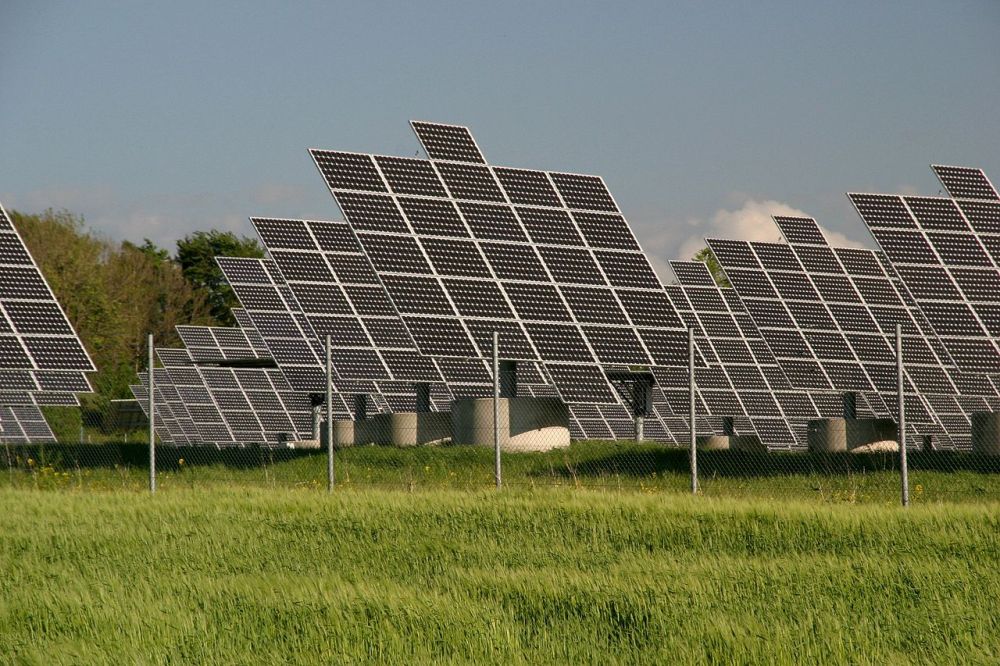
“Solar park” or “PV farm”
A photovoltaic system (informally, PV system) is an arrangement of components designed to supply usable electric power for a variety of purposes, using the Sun (or, less commonly, other light sources) as the power source.
PV systems may be built in various configurations:
- Off-grid without battery (array-direct)
- Off-grid with battery storage for DC-only appliances
- Off-grid with battery storage for AC and DC appliances
- Grid-tie without battery
- Grid-tie with battery storage
A photovoltaicarray (also called a solar array) consists of multiple photovoltaic modules, casually referred to as solar panels, to convert solar radiation (sunlight) into usable direct current (DC) electricity. A photovoltaic system for residential, commercial, or industrial energy supply normally contains an array of photovoltaic (PV) modules, one or more DC to alternating current (AC) power converters (also known as inverters), a racking system that supports the solar modules, electrical wiring and interconnections, and mounting for other components. Optionally, a photovoltaic system may include any or all of the following: renewable energy credit revenue-grade meter, maximum power point tracker (MPPT), battery system and charger, GPSsolar tracker, energy management software, solar concentrators, solar irradiance sensors, anemometer, or task-specific accessories designed to meet specialized requirements for a system owner. The number of modules in the system determines the total DC watts capable of being generated by the solar array; however, the inverter ultimately governs the amount of AC watts that can be distributed for consumption. For example: A PV system comprising 11 kilowatts DC (kWDC) worth of PV modules, paired with one 10-kilowatt AC (kWAC) inverter, will be limited by the maximum output of the inverter: 10 kW AC.
A small PV system is capable of providing enough AC electricity to power a single home, or even an isolated device in the form of AC or DC electric. For example, military and civilian Earth observation satellites, street lights, construction and traffic signs, electric cars, solar-powered tents,[1] and electric aircraft may contain integrated photovoltaic systems to provide a primary or auxiliary power source in the form of AC or DC power, depending on the design and power demands.
Large grid-connected photovoltaic power systems are capable of providing an energy supply for multiple consumers. The electricity generated can be stored, used directly (island/standalone plant), fed into a large electricity grid powered by central generation plants (grid-connected or grid-tied plant), or combined with one, or many, domestic electricity generators to feed into a small electrical grid (hybrid plant).[2][3] PV systems are generally designed in order to ensure the highest energy yield for a given investment.
In the United States, the Authority Having Jurisdiction (AHJ) will review designs and issue permits, before construction can lawfully begin. Electrical installation practices must comply with standards set forth within the National Electrical Code (NEC) and be inspected by the AHJ to ensure compliance with building code, electrical code, and fire safety code. Jurisdictions may require that equipment has been tested, certified, listed, and labeled by at least one of the Nationally Recognized Testing Laboratories
Components
Silicon Boule & Solar Cell
In order to make a Monocrystalline solar cell, a silicon ingot, also known as a silicon boule (crystal), must first be produced. Once a silicon ingot has been made, it is thinly sliced and semiconductors are imbedded in the disk.[5] The silicon disk will have positive and negative leads, which serve as connection points to tie multiple cells in series. Once multiple cells are connected in series, the formation of a module begins. Other types of solar cells are available. See List of types of solar cells.
Amorphous Silicon Cell
Although this cell has the same elements as a monocrystalline solar cell, the main difference between each is the degradation period as well as price to produce the cell. Although technology is supposed to improve this technology, the monocrystalline cell is considered better, as there has been more advances and applications used for this type of cell.[6]
Photovoltaic modules
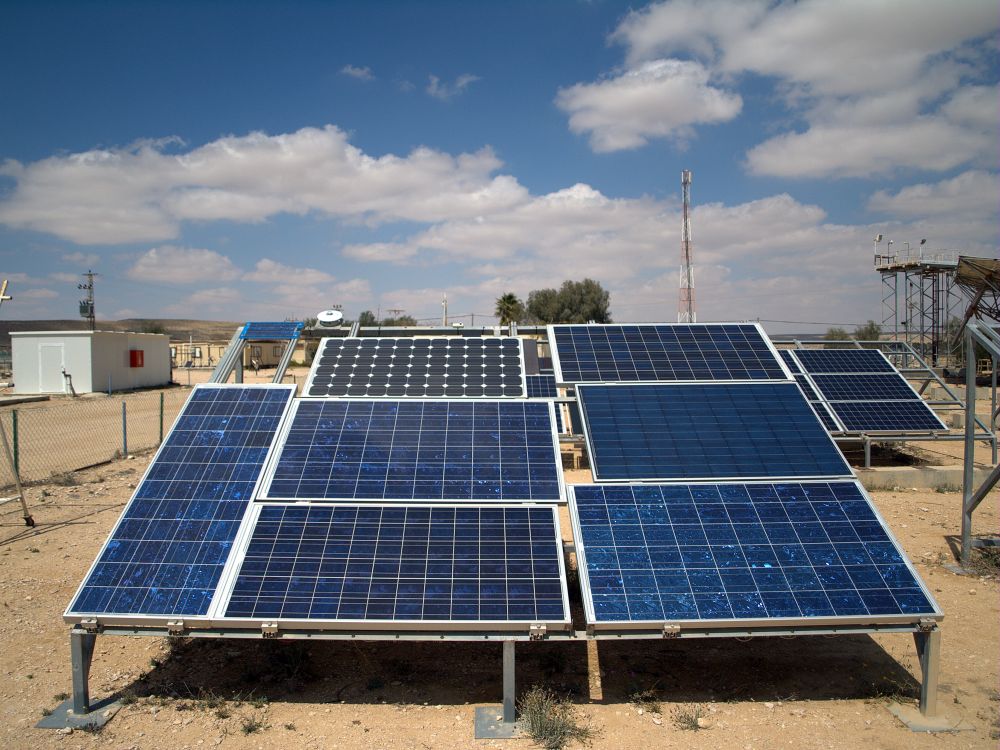

Due to the low voltage of an individual solar cell (typically ca. 0.5V), several cells are wired (see: Copper in photovoltaic power systems) in series in the manufacture of a “laminate”. The laminate is assembled into a protective weatherproof enclosure, thus making a photovoltaic module or solar panel. Modules may then be strung together into a photovoltaic array.
Photovoltaic arrays
A photovoltaic array (or solar array) is a linked collection of solar panels.[7] The power that one module can produce is seldom enough to meet requirements of a home or a business, so the modules are linked together to form an array. Most PV arrays use an inverter to convert the DC power produced by the modules into alternating current that can power lights, motors, and other loads. The modules in a PV array are usually first connected in series to obtain the desired voltage; the individual strings are then connected in parallel to allow the system to produce more current. Solar panels are typically measured under STC (standard test conditions) or PTC (PVUSA test conditions), in watts.[8] Typical panel ratings range from less than 100 watts to over 400 watts.[9] The array rating consists of a summation of the panel ratings, in watts, kilowatts, or megawatts.
Mounting systems
Modules are assembled into arrays on some kind of mounting system, which may be classified as ground mount, roof mount or pole mount. For solar parks a large rack is mounted on the ground, and the modules mounted on the rack. For buildings, many different racks have been devised for pitched roofs. For flat roofs, racks, bins and building integrated solutions are used.[citation needed] Solar panel racks mounted on top of poles can be stationary or moving, see Trackers below. Side-of-pole mounts are suitable for situations where a pole has something else mounted at its top, such as a light fixture or an antenna. Pole mounting raises what would otherwise be a ground mounted array above weed shadows and livestock, and may satisfy electrical code requirements regarding inaccessibility of exposed wiring. Pole mounted panels are open to more cooling air on their underside, which increases performance. A multiplicity of pole top racks can be formed into a parking carport or other shade structure. A rack which does not follow the sun from left to right may allow seasonal adjustment up or down.
Trackers
A solar tracker tilts a solar panel throughout the day. Depending on the type of tracking system, the panel is either aimed directly at the sun or the brightest area of a partly clouded sky. Trackers greatly enhance early morning and late afternoon performance, increasing the total amount of power produced by a system by about 20–25% for a single axis tracker and about 30% or more for a dual axis tracker, depending on latitude.[10][11] Trackers are effective in regions that receive a large portion of sunlight directly. In diffuse light (i.e. under cloud or fog), tracking has little or no value. Because most concentrated photovoltaics systems are very sensitive to the sunlight’s angle, tracking systems allow them to produce useful power for more than a brief period each day.[12] Tracking systems improve performance for two main reasons. First, when a solar panel is perpendicular to the sunlight, it receives more light on its surface than if it were angled. Second, direct light is used more efficiently than angled light[citation needed]. Special Anti-reflective coatings can improve solar panel efficiency for direct and angled light, somewhat reducing the benefit of tracking.[13]
Inverters
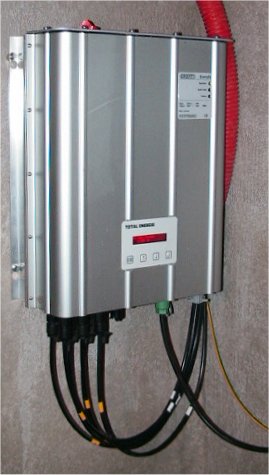
Systems designed to deliver alternating current (AC), such as grid-connected applications need an inverter to convert the direct current (DC) from the solar modules to AC. Grid connected inverters must supply AC electricity in sinusoidal form, synchronized to the grid frequency, limit feed in voltage to no higher than the grid voltage and disconnect from the grid if the grid voltage is turned off.[14] Islanding inverters need only produce regulated voltages and frequencies in a sinusoidal waveshape as no synchronisation or co-ordination with grid supplies is required. A solar inverter may connect to a string of solar panels. In some installations a solar micro-inverter is connected at each solar panel.[15] For safety reasons a circuit breaker is provided both on the AC and DC side to enable maintenance. AC output may be connected through an electricity meter into the public grid.[16]
Maximum power point tracking and charge control
Maximum power point tracking (MPPT) is used to maximize module output power. The power output of a module varies as a function of the voltage in a way that power generation can be optimized by varying the system voltage to find the ‘maximum power point’. Some inverters incorporate maximum power point tracking.[17]
In the case of PV systems which include a battery, a charge controller[18] is needed to adjust the constantly varying voltage and current available from PV panels, to correctly charge the battery. Basic charge controllers may simply turn the PV panels on and off, or may meter out pulses of energy as needed, a strategy called PWM or pulse-width modulation. More advanced charge controllers will incorporate MPPT logic into their battery charging algorithms. Charge controllers may also divert energy to some purpose other than battery charging. Rather than simply shut off the free PV energy when not needed, a user may choose to heat air or water once the battery is full.
A charge controller with MPPT capability frees the system designer from closely matching available PV voltage to battery voltage. Considerable efficiency gains can be achieved, particularly when the PV array is located at some distance from the battery. By way of example, a 150 volt PV array connected to an MPPT charge controller can be used to charge a 24 or 48 volt battery. Higher array voltage means lower array current, so the savings in wiring costs can more than pay for the controller.
Monitoring and metering
The metering must be able to accumulate energy units in both directions or two meters must be used. Many meters accumulate bidirectionally, some systems use two meters, but a unidirectional meter (with detent) will not accumulate energy from any resultant feed into the grid.[19]
In some countries, for installations over 30kWp a frequency and a voltage monitor with disconnection of all phases is required. This is done to prevent supplying excess power to the grid, in the unusual case where more solar power is being generated than can be accommodated by the utility, and can not either be exported or stored. Grid operators historically have needed to provide transmission lines and generation capacity. Now they need to also provide storage. This is normally hydro-storage, but other means of storage are used. Initially storage was used so that baseload generators could operate at full output. With variable renewable energy, storage is needed to allow power generation whenever it is available, and consumption whenever it is needed. The two variables a grid operator have are storing electricity for when it is needed, or transmitting it to where it is needed. If both of those fail, installations over 30kWp can automatically shut down, although in practice all inverters maintain voltage regulation and stop supplying power if the load is inadequate. Grid operators have the option of curtailing excess generation from large systems, although this is more commonly done with wind power than solar power, and results in a substantial loss of revenue.[20] Inverters have the unique option of supplying reactive power which can be advantageous in matching load requirements.[21]
Standalone applications
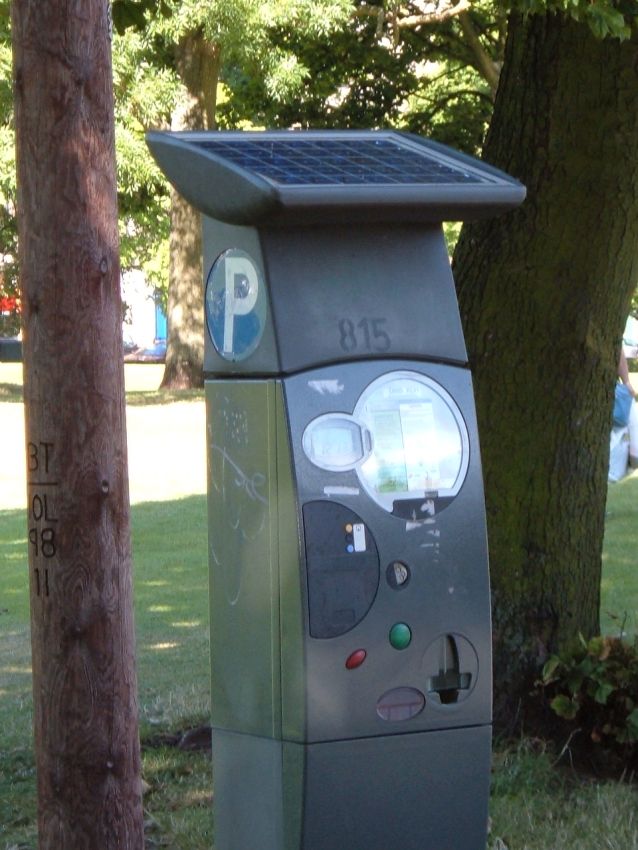
Solar powered parking meter.
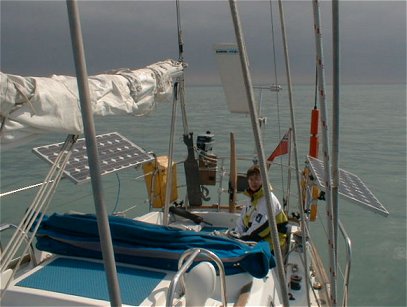
The solar panels on this small yacht at sea can charge the 12 volt batteries at up to 9 amperes in full, direct sunlight.
A standalone system does not have a connection to the electricity “mains” (aka “grid”). Standalone systems vary widely in size and application from wristwatches or calculators to remote buildings or spacecraft. If the load is to be supplied independently of solar insolation, the generated power is stored and buffered with a battery. In non-portable applications where weight is not an issue, such as in buildings, lead acid batteries are most commonly used for their low cost and tolerance for abuse. A charge controller may be incorporated in the system to: a) avoid battery damage by excessive charging or discharging and, b) optimizing the production of the cells or modules by maximum power point tracking (MPPT). However, in simple PV systems where the PV module voltage is matched to the battery voltage, the use of MPPT electronics is generally considered unnecessary, since the battery voltage is stable enough to provide near-maximum power collection from the PV module. In small devices (e.g. calculators, parking meters) only direct current (DC) is consumed. In larger systems (e.g. buildings, remote water pumps) AC is usually required. To convert the DC from the modules or batteries into AC, an inverter is used.
Solar vehicles
Ground, water, air or space vehicles may obtain some or all of the energy required for their operation from the sun. Surface vehicles generally require higher power levels than can be sustained by a practically sized solar array, so a battery is used to meet peak power demand, and the solar array recharges it. Space vehicles have successfully used solar photovoltaic systems for years of operation, eliminating the weight of fuel or primary batteries.
Small scale solar systems

Profile picture of a mobile solar powered generator
With a growing DIY-community and an increasing interest in environmentally friendly “green energy“, some hobbyists have endeavored to build their own PV solar systems from kits[22] or partly diy.[23] Usually, the DIY-community uses inexpensive[24] or high efficiency systems[25] (such as those with solar tracking) to generate their own power. As a result, the DIY-systems often end up cheaper than their commercial counterparts.[26] Often, the system is also hooked up into the regular power grid, using net metering instead of a battery for backup. These systems usually generate power amount of ~2 kW or less. Through the internet, the community is now able to obtain plans to construct the system (at least partly DIY) and there is a growing trend toward building them for domestic requirements. Small scale solar systems are now also being used both in developed countries and in developing countries, for residences and small businesses.[27][28] One of the most cost effective solar applications is a solar powered pump, as it is far cheaper to purchase a solar panel than it is to run power lines.[29]
Grid-connected applications
A grid connected system is connected to a larger independent grid (typically the public electricity grid) and feeds energy directly into the grid. This energy may be shared by a residential or commercial building before or after the revenue measurement point. The difference being whether the credited energy production is calculated independently of the customer’s energy consumption (feed-in tariff) or only on the difference of energy (net metering). Grid connected systems vary in size from residential (2-10kWp) to solar power stations (up to 10s of MWp). This is a form of decentralized electricity generation. The feeding of electricity into the grid requires the transformation of DC into AC by a special, synchronising grid-tie inverter.[30] In kW sized installations the DC side system voltage is as high as permitted (typically 1000V except US residential 600V) to limit ohmic losses. Most modules (72 crystalline silicon cells) generate 160W to 300W at 36 volts. It is sometimes necessary or desirable to connect the modules partially in parallel rather than all in series. One set of modules connected in series is known as a ‘string’.[31]
Connection to DC grids
DC grids are found in electric powered transport: railways trams and trolleybuses. A few pilot plants for such applications have been built, such as the tram depots in Hannover Leinhausen, using photovoltaic contributors[32] and Geneva (Bachet de Pesay).[33] The 150 kWp Geneva site feeds 600V DC directly into the tram/trolleybus electricity network whereas before it provided about 15% of the electricity at its opening in 1999.
Building-mounted and building-integrated systems
In urban and suburban areas, photovoltaic arrays are commonly used on rooftops to supplement power use; often the building will have a connection to the power grid, in which case the energy produced by the PV array can be sold back to the utility in some sort of net metering agreement. Some utilities, such as Solvay Electric in Solvay, NY, use the rooftops of commercial customers and telephone poles to support their use of PV panels.[34]Solar trees are arrays that, as the name implies, mimic the look of trees, provide shade, and at night can function as street lights. In agricultural settings, the array may be used to directly power DC pumps, without the need for an inverter. In remote settings such as mountainous areas, islands, or other places where a power grid is unavailable, solar arrays can be used as the sole source of electricity, usually by charging a storage battery.[citation needed] There is financial support available for people wishing to install PV arrays. Incentives range from federal tax credits to state tax credits and rebates to utility loans and rebates. A listing of current incentives can be found at the Database of State Incentives for Renewables and Efficiency. In the UK, households are paid a ‘Feedback Fee’ to buy excess electricity at a flat rate per kWh. This is up to 44.3p/kWh which can allow a home to earn double their usual annual domestic electricity bill.[35] The current UK feed-in tariff system is due for review on 31 March 2012, after which the current scheme may no longer be available.[36][need quotation to verify]
Power plants
A photovoltaic power station (solar park or solar farm) is a power station using photovoltaic modules and inverters for utility scale electricity generation, connected to an electricity transmission grid. Some large photovoltaic power stations like Waldpolenz Solar Park and Topaz Solar Farm cover tens or hundreds of hectares and have power outputs up to hundreds of megawatts.
System performance
Insolation and energy
Solar insolation is made up of direct radiation, diffuse radiation and reflected radiation (or albedo).The absorption factor of a PV cell is defined as the fraction of incident solar irradiance that is absorbed by the cell.[37] At high noon on a cloudless day at the equator, the power of the sun is about 1 kW/m²,[38] on the Earth’s surface, to a plane that is perpendicular to the sun’s rays. As such, PV arrays can track the sun through each day to greatly enhance energy collection. However, tracking devices add cost, and require maintenance, so it is more common for PV arrays to have fixed mounts that tilt the array and face solar noon (approximately due south in the Northern Hemisphere or due north in the Southern Hemisphere). The tilt angle, from horizontal, can be varied for season,[39] but if fixed, should be set to give optimal array output during the peak electrical demand portion of a typical year for a stand alone system. This optimal module tilt angle is not necessarily identical to the tilt angle for maximum annual array energy output.[40] The optimization of the a photovoltaic system for a specific environment can be complicated as issues of solar flux, soiling, and snow losses should be taken into effect. In addition, recent work has shown that spectral effects can play a role in optimal photovoltaic material selection. For example, the spectral albedo can play a significant role in output depending on the surface around the photovoltaic system.[41]
For the weather and latitudes of the United States and Europe, typical insolation ranges from 4 kWh/m²/day in northern climes to 6.5 kWh/m²/day in the sunniest regions. Typical solar panels have an average efficiency of 15%, with the best commercially available panels at 21%. Thus, a photovoltaic installation in the southern latitudes of Europe or the United States may expect to produce 1 kWh/m²/day. A typical “150 watt” solar panel is about a square meter in size. Such a panel may be expected to produce 0.75 kWh every day, on average, after taking into account the weather and the latitude, for an insolation of 5 sun hours/day. A typical 1 kW photovoltaic installation in Australia or the southern latitudes of Europe or United States, may produce 3.5-5 kWh per day, dependent on location, orientation, tilt, insolation and other factors.[42] In the Sahara desert, with less cloud cover and a better solar angle, one could ideally obtain closer to 8.3 kWh/m²/day provided the nearly ever present wind would not blow sand onto the units. The area of the Sahara desert is over 9 million km². 90,600 km², or about 1%, could generate as much electricity as all of the world’s power plants combined.[43]
Tracking the sun
Trackers and sensors to optimise the performance are often seen as optional, but tracking systems can increase viable output by up to 45%.[7][44] PV arrays that approach or exceed one megawatt often use solar trackers. Accounting for clouds, and the fact that most of the world is not on the equator, and that the sun sets in the evening, the correct measure of solar power is insolation – the average number of kilowatt-hours per square meter per day. For the weather and latitudes of the United States and Europe, typical insolation ranges from 2.26 kWh/m²/day in northern climes to 5.61 kWh/m²/day in the sunniest regions.[45][46]
For large systems, the energy gained by using tracking systems can outweigh the added complexity (trackers can increase efficiency by 30% or more). For very large systems, the added maintenance of tracking is a substantial detriment.[47] Tracking is not required for flat panel and low concentration concentrated photovoltaic systems. For high concentration concentrated photovoltaic systems, dual axis tracking is a necessity.[48]
Pricing trends affect the balance between adding more stationary solar panels versus having fewer panels that track. When solar panel prices drop, trackers become a less attractive option.
Shading and dirt
Photovoltaic cell electrical output is extremely sensitive to shading. The effects of this shading are well known.[49][50][51] When even a small portion of a cell, module, or array is shaded, while the remainder is in sunlight, the output falls dramatically due to internal ‘short-circuiting’ (the electrons reversing course through the shaded portion of the p-n junction). If the current drawn from the series string of cells is no greater than the current that can be produced by the shaded cell, the current (and so power) developed by the string is limited. If enough voltage is available from the rest of the cells in a string, current will be forced through the cell by breaking down the junction in the shaded portion. This breakdown voltage in common cells is between 10 and 30 volts. Instead of adding to the power produced by the panel, the shaded cell absorbs power, turning it into heat. Since the reverse voltage of a shaded cell is much greater than the forward voltage of an illuminated cell, one shaded cell can absorb the power of many other cells in the string, disproportionately affecting panel output. For example, a shaded cell may drop 8 volts, instead of adding 0.5 volts, at a particular current level, thereby absorbing the power produced by 16 other cells.[52] It is, thus important that a PV installation is not shaded by trees or other obstructions. Several methods have been developed to determine shading losses from trees to PV systems over both large regions using LiDAR,[53] but also at an individual system level using sketchup.[54] Most modules have bypass diodes between each cell or string of cells that minimize the effects of shading and only lose the power of the shaded portion of the array. The main job of the bypass diode is to eliminate hot spots that form on cells that can cause further damage to the array, and cause fires. Sunlight can be absorbed by dust, snow, or other impurities at the surface of the module. This can reduce the light that strikes the cells. In general these losses aggregated over the year are small even for locations in Canada.[55] Maintaining a clean module surface will increase output performance over the life of the module. Google found that cleaning the flat mounted solar panels after 15 months increased their output by almost 100%, but that the 5% tilted arrays were adequately cleaned by rainwater.[56][57]
Temperature
Module output and life are also degraded by increased temperature. Allowing ambient air to flow over, and if possible behind, PV modules reduces this problem.
Module efficiency
In 2012, solar panels available for consumers can have an efficiency of up to about 17%,[58] while commercially available panels can go as far as 27%. It has been recorded that a group from the The Fraunhofer Institute for Solar Energy Systems have created a cell that can reach 44.7% efficiency, which will make scientists hopes to reach the 50% efficiency threshold a lot more feasible. Efficiency derives from Carnot’s cycle, which determines efficiency from changes in temperature. Researchers used a different method called the step Carnot cycle, which helps to determine the maximum power efficiency, as this method can help refine the efficiency of photovoltaics.[59][60][61][62]
Monitoring
Photovoltaic systems need to be monitored to detect breakdown and optimize their operation. Several photovoltaic monitoring strategies depending on the output of the installation and its nature. Monitoring can be performed on site or remotely. It can measure production only, retrieve all the data from the inverter or retrieve all of the data from the communicating equipment (probes, meters, etc.). Monitoring tools can be dedicated to supervision only or offer additional functions. Individual inverters and battery charge controllers may include monitoring using manufacturer specific protocols and software.[63] Energy metering of an inverter may be of limited accuracy and not suitable for revenue metering purposes. A third-party data acquisition system can monitor multiple inverters, using the inverter manufacturer’s protocols, and also acquire weather-related information. Independent smart meters may measure the total energy production of a PV array system. Separate measures such as satellite image analysis or a solar radiation meter (a pyranometer) can be used to estimate total insolation for comparison.[64] Data collected from a monitoring system can be displayed remotely over the World Wide Web. For example, the Open Solar Outdoors Test Field (OSOTF)[65] is a grid-connected photovoltaic test system, which continuously monitors the output of a number of photovoltaic modules and correlates their performance to a long list of highly accurate meteorological readings. The OSOTF is organized under open source principles—All data and analysis is be made freely available to the entire photovoltaic community and the general public.[66] The Fraunhofer Center for Sustainable Energy Systems maintains two test systems, one in Massachusetts, and the Outdoor Solar Test Field OTF-1 in Albuquerque, New Mexico, which opened in June 2012. A third site, OTF-2, also in Albuquerque, is under construction.[67] Some companies offer analysis software to analyze system performance. Small residential systems may have minimal data analysis requirements other than perhaps total energy production; larger grid-connected power plants can benefit from more detailed investigations of performance.
Performance factors
Uncertainties in revenue over time relate mostly to the evaluation of the solar resource and to the performance of the system itself. In the best of cases, uncertainties are typically 4% for year-to-year climate variability, 5% for solar resource estimation (in a horizontal plane), 3% for estimation of irradiation in the plane of the array, 3% for power rating of modules, 2% for losses due to dirt and soiling, 1.5% for losses due to snow, and 5% for other sources of error. Identifying and reacting to manageable losses is critical for revenue and O&M efficiency. Monitoring of array performance may be part of contractual agreements between the array owner, the builder, and the utility purchasing the energy produced.[citation needed] Recently, a method to create “synthetic days” using readily available weather data and verification using the Open Solar Outdoors Test Field make it possible to predict photovoltaic systems performance with high degrees of accuracy.[71] This method can be used to then determine loss mechanisms on a local scale – such as those from snow [55][57] or the effects of surface coatings (e.g. hydrophobic or hydrophilic) on soiling or snow losses.[72] Access to the Internet has allowed a further improvement in energy monitoring and communication. Dedicated systems are available from a number of vendors. For solar PV system that use microinverters (panel-level DC to AC conversion), module power data is automatically provided. Some systems allow setting performance alerts that trigger phone/email/text warnings when limits are reached. These solutions provide data for the system owner and the installer. Installers are able to remotely monitor multiple installations, and see at-a-glance the status of their entire installed base.[citation needed]
Module life
Effective module lives are typically 25 years or more.[73] The payback period for an investment in a PV solar installation varies greatly and is typically less useful than a calculation of return on investment.[74] While it is typically calculated to be between 10 and 20 years, the payback period can be far shorter with incentives.[75]
Hybrid systems
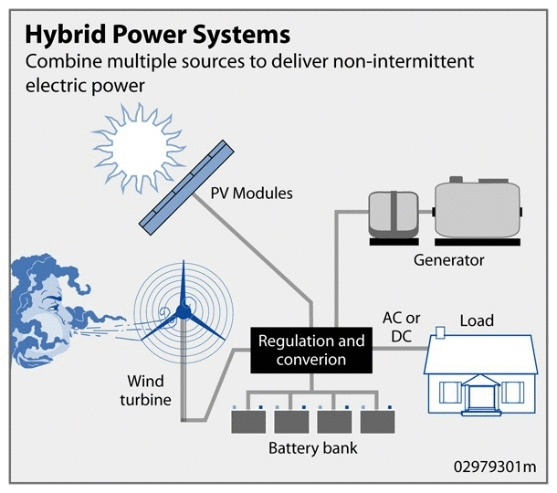
A hybrid system combines PV with other forms of generation, usually a diesel generator. Biogas is also used. The other form of generation may be a type able to modulate power output as a function of demand. However more than one renewable form of energy may be used e.g. wind. The photovoltaic power generation serves to reduce the consumption of non renewable fuel. Hybrid systems are most often found on islands. Pellworm island in Germany and Kythnos island in Greece are notable examples (both are combined with wind).[76][77] The Kythnos plant has reduced diesel consumption by 11.2%[78]
There has also been recent work showing that the PV penetration limit can be increased by deploying a distributed network of PV+CHP hybrid systems in the U.S.[79] The temporal distribution of solar flux, electrical and heating requirements for representative U.S. single family residences were analyzed and the results clearly show that hybridizing CHP with PV can enable additional PV deployment above what is possible with a conventional centralized electric generation system. This theory was reconfirmed with numerical simulations using per second solar flux data to determine that the necessary battery backup to provide for such a hybrid system is possible with relatively small and inexpensive battery systems.[80] In addition, large PV+CHP systems are possible for institutional buildings, which again provide back up for intermittent PV and reduce CHP runtime.[81]
Standardization
Increasing use of photovoltaic systems and integration of photovoltaic power into existing structures and techniques of supply and distribution increases the value of general standards and definitions for photovoltaic components and systems.[citation needed] The standards are compiled at the International Electrotechnical Commission (IEC) and apply to efficiency, durability and safety of cells, modules, simulation programs, plug connectors and cables, mounting systems, overall efficiency of inverters etc.[82]
Costs and economy
Costs of production have been reduced in recent years for more widespread use through production and technological advances. For large-scale installations, prices below $1.00 per watt are now common.[83] Crystal silicon solar cells have largely been replaced by less expensive multicrystalline silicon solar cells, and thin film silicon solar cells have also been developed recently at lower costs of production. Although they are reduced in energy conversion efficiency from single crystalline “siwafers”, they are also much easier to produce at comparably lower costs.[84]
Energy costs
The table below shows the total cost in US cents per kWh of electricity generated by a photovoltaic system.[85][86] The row headings on the left show the total cost, per peak kilowatt (kWp), of a photovoltaic installation. Photovoltaic system costs have been declining and in Germany, for example, were reported to have fallen to USD 2200/kWp by the second quarter of 2012.[87] The column headings across the top refer to the annual energy output in kWh expected from each installed kWp. This varies by geographic region because the average insolation depends on the average cloudiness and the thickness of atmosphere traversed by the sunlight. It also depends on the path of the sun relative to the panel and the horizon. Panels are usually mounted at an angle based on latitude, and often they are adjusted seasonally to meet the changing solar declination. Solar tracking can also be utilized to access even more perpendicular sunlight, thereby raising the total energy output.
The calculated values in the table reflect the total cost in cents per kWh produced. They assume a 10% total capital cost (for instance 4% interest rate, 1% operating and maintenance cost,[88] and depreciation of the capital outlay over 20 years). Normally, photovoltaic modules have a 25 year warranty.[89][90]
| 20 years | 2400 kWh/kWp y |
2200 kWh/kWp y |
2000 kWh/kWp y |
1800 kWh/kWp y |
1600 kWh/kWp y |
1400 kWh/kWp y |
1200 kWh/kWp y |
1000 kWh/kWp y |
800 kWh/kWp y |
|---|---|---|---|---|---|---|---|---|---|
| $200 /kWp | 0.8 | 0.9 | 1.0 | 1.1 | 1.3 | 1.4 | 1.7 | 2.0 | 2.5 |
| $600 /kWp | 2.5 | 2.7 | 3.0 | 3.3 | 3.8 | 4.3 | 5.0 | 6.0 | 7.5 |
| $1000 /kWp | 4.2 | 4.5 | 5.0 | 5.6 | 6.3 | 7.1 | 8.3 | 10.0 | 12.5 |
| $1400 /kWp | 5.8 | 6.4 | 7.0 | 7.8 | 8.8 | 10.0 | 11.7 | 14.0 | 17.5 |
| $1800 /kWp | 7.5 | 8.2 | 9.0 | 10.0 | 11.3 | 12.9 | 15.0 | 18.0 | 22.5 |
| $2200 /kWp | 9.2 | 10.0 | 11.0 | 12.2 | 13.8 | 15.7 | 18.3 | 22.0 | 27.5 |
| $2600 /kWp | 10.8 | 11.8 | 13.0 | 14.4 | 16.3 | 18.6 | 21.7 | 26.0 | 32.5 |
| $3000 /kWp | 12.5 | 13.6 | 15.0 | 16.7 | 18.8 | 21.4 | 25.0 | 30.0 | 37.5 |

